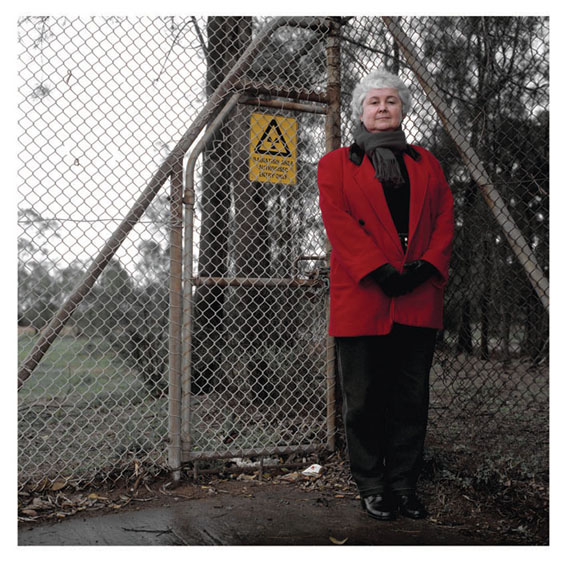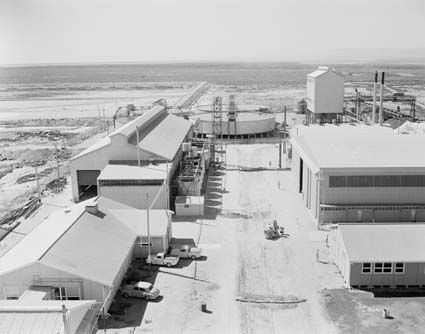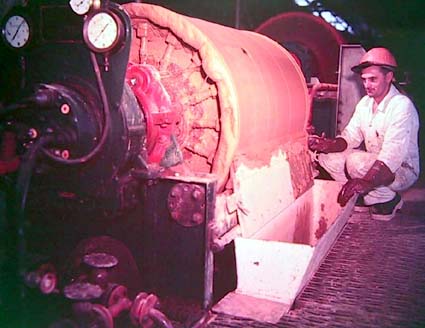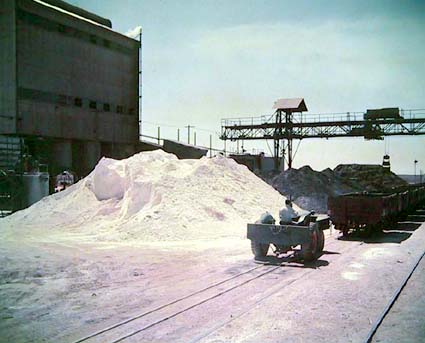The Combined Development Agency (CDA) was established in 1948 by the governments of the United States and the United Kingdom to ensure adequate supplies of uranium for nuclear weapons development programs. In Australia, uranium ore was processed at the Port Pirie Uranium Treatment Complex (PPUTC), which was operated by the South Australian government’s mines department under contract to the CDA.
The PPUTC was situated north of the township of Port Pirie, approximately one kilometre west of the Port Pirie River. The £1.8 million complex commenced operations in August 1955 and closed in February 1962. It processed ore from Radium Hill and Wild Dog Hill (Myponga), 64 kms south of Adelaide.
The PPUTC was designed to produce 160 tonnes of uranium oxide per year. It produced 852 tonnes of U3O8 from 1956 to 1962, valued at A$36 million or ₤15 million. The Myponga mine contributed just over one tonne of U3O8 in 1954-55, from 340 tonnes of ore; thus Radium Hill was by far the main source of uranium ore.
The PPUTC consisted of three parts:
- Leaching of uranium concentrate to dissolve the uranium-bearing mineral using 98% sulphuric acid.
- Separation of the liquid carrying the uranium from spent ore after leaching (counter current decantation plant). In this process, the uranium-rich liquid was separated from the solids by passing through thickeners. The washed, spent ore was mixed with waste liquid from the plant and pumped to the tailings dams.
- Recovery of the uranium by precipitation of the uranium salt. This material was dried using a hot blast type unit. The outgoing air passed through an electrostatic precipitation unit to remove uranium dust before discharging to the atmosphere.
TAILINGS
Six clay-lined dams were constructed for the storage of tailings and waste water generated in the uranium extraction process.
Additional tailings material was produced from the processing of rare earths (e.g. scandium and yttrium). During the early 1960s, the Rare Earth Corporation (REC) operated on the site, extracting scandium, yttrium oxide and other rare earths from the uranium tailings and some imported material. As part of the operations, four smaller dams were built immediately to the east of the uranium tailings dams. A monazite cracking plant was later set up on the site and operated from 1969 to 1972. The by-products from this industry, which include monazite residues containing elevated levels of radionuclides (mainly thorium), were deposited in the REC dams.
Thus the site has the six original uranium tailings dams and four smaller rare earth tailings dams − in total these cover approximately 26 hectares and contain about 200,000 tonnes of tailings.
A number of significant management issues have arisen from the storage of tailings at the PPUTC:
- first, from the close proximity of homes to the dams (within 300 metres);
- second, due to the lack of fencing, the site was used as a playground for children over a number of years; and
- third, from the insufficient height of the tailings walls which failed during the high tides of 1981.
After six years of community pressure and after high tides breached the walls of the tailings dam in 1981, the dam wall was increased in height; the tailings were covered under a metre of slag, clay and topsoil; the area was re-fenced; and a trench was constructed to drain run-off water into an evaporation pond. It took 30 years to take these stop-gap remedial measures. The financial cost to the South Australian public was about $1 million.
 Jenny Lewis (pictured) was a prominent member of the local campaign group that succeeded in getting the Port Pirie tailings fenced off and partially remediated. To hear Jenny talk about her experiences click here.
Jenny Lewis (pictured) was a prominent member of the local campaign group that succeeded in getting the Port Pirie tailings fenced off and partially remediated. To hear Jenny talk about her experiences click here.
According to the 1997 Senate Select Committee on Uranium Mining and Milling report: “The Committee is not convinced, on the evidence before it, that rehabilitation and remedial work has been satisfactorily completed. It recommends a full public evaluation of the work as soon as possible and that the sites be reappraised at intervals of not more than two years.”
The SA government’s 2003 ‘Audit of Radioactive Waste‘ recommended that long-term management plans be developed as required by conditions of registration of the Port Pirie site under the SA Radiation Protection and Control Act 1982. The report states: “In the mid 1980s, slag from the adjacent Pasminco smelter was used to cover dams 2, 3 and 4 and parts of dams 1 and 5 to minimise radon emissions and any potential for dust emission. From 1989 to 1990 the plant area was surveyed and partially decontaminated, and contaminated soil and other material was deposited in the eastern end of dams 5 and 6. The slag coverage was recently extended to cover the northern end of the former processing plant area following the demolition of the original processing tanks.”
The SA government established a Community Focus Group in 2005 in collaboration with the Port Pirie Regional Development Board. The purpose was to establish an effective forum to provide a review process and communication link between the project management team and the community of Port Pirie relating to the management and potential remediation of the PPUTC.
Further work was carried out in 2005−2006 including
- assessment of the structural integrity of the tailings impoundments;
- identification and sampling of radiometric and other contaminant anomalies;
- radiological testing of buildings prior to demolition, then demolition and dismantling of all buildings and infrastructure, and removal of the majority of the original foundations;
- quantification of all existing wastes, covers etc.;
- work to determine what economic value and potential remain (if any) in the residue products on-site, namely the tailings resulting from the original extraction of uranium; and
- hydrogeological investigation.
As of June 2012 the SA government’s website indicates that the following work is in progress:
- groundwater sampling and monitoring to determine what mechanisms and processes are occurring with respect to hydrogeological conditions at the site;
- plant site cleanup − disposal of remaining plant and equipment; and
- risk assessment and control scoping study to quantify and assess the level of risk associated with the site with respect to both radiological and non-radiological impacts.
June 2012 correspondence from the SA Department of Manufacturing, Innovation, Trade, Resources and Energy states: “The site assessment works were undertaken to inform the department in developing the long term planning and management of the sites. As a follow on from these works, the sites are actively monitored to provide additional information to assist with the ongoing development of management plans and potential remediation.”
Thus there are outstanding environmental and public health issues 50 years after the closure of the PPUTC, and Port Pirie can be added to the list of uranium mines and plants with ongoing problems and concerns decades after their closure.
Although the uranium grades at Radium Hill were moderate to low, the rare earths grade was exceptional, with values up to 7% rare earth oxides. A proposal was made public in the late 1980s to mine and extract the rare earths from the remnant tailings at Port Pirie. However the project was abandoned due to intense public opposition.
MORE INFORMATION:
- SEA-US: http://web.archive.org/web/20060624103944/http://www.sea-us.org.au/oldmines/portpirie.html
- historical information and photos: http://trove.nla.gov.au/result?q=port+pirie+uranium
- SA government: http://www.pir.sa.gov.au/minerals/mines__and__developing_projects/former_mines/port_pirie_treatment_plant
- McLeary, M., 2004, ‘Port Pirie Uranium Treatment Plant Site: Management Plan Phase 1, Preliminary Investigation’, PIRSA Report Book 2004/10, http://www.pir.sa.gov.au/__data/assets/pdf_file/0016/32533/rb2004_010_ptpirie_u.pdf
 Above: A 1958 photograph. Ore concentrates were leached in boiling sulphuric acid to dissolve the uranium, which was precipitated, after further processing, as yellowcake. Leaching vats were housed in the tall building to the right of the four thickening tanks. The tanks were used to settle out solids from the waste material, and water was returned to the plant for re-use; the thickened solids were pumped into the tailings dams at left.
Above: A 1958 photograph. Ore concentrates were leached in boiling sulphuric acid to dissolve the uranium, which was precipitated, after further processing, as yellowcake. Leaching vats were housed in the tall building to the right of the four thickening tanks. The tanks were used to settle out solids from the waste material, and water was returned to the plant for re-use; the thickened solids were pumped into the tailings dams at left.
[This webpage last updated June 2012.]





